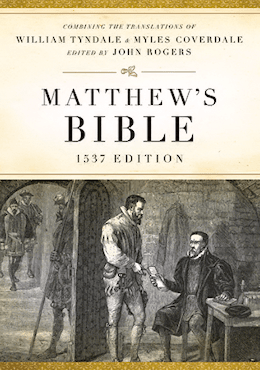Textus Receptus Bibles
Matthew's Bible 1537
| 6:1 | Whither is thy loue gone then (O thou fayrest amonge women) whither is thy loue departed, that we may seke hym with the? |
| 6:2 | My loue is gone doune into hys garden, vnto the swete smelling beddes, that he maye refreshe him self in the garden, and gather floures. |
| 6:3 | My loue is myne and I am hys, which fedeth among the Lylyes. |
| 6:4 | Thou art pleasaunt (O my loue) euen as louelynesse it self, thou art fayre as Ierusalem, glorious as an army of men, with their banners. |
| 6:5 | (Turne awaye thyne eyes fro me, for thei make me to proude.) Thy heery lockes are lyke a flocke of goates vpon the mount of Galaad. |
| 6:6 | Thy teth are like a flocke of shepe that be clypped, which go out of the wasshyng place: where euery one beareth twoo twynes, and not one vnfruteful among them. |
| 6:7 | Thy chekes are lyke a pece of pomegranate besydes that which lyeth hyd within. |
| 6:8 | There are thre score Quenes, foure score concubines, & yong women without numbre. |
| 6:9 | But one is my doue, my derling. She is the onely beloued of her mother, and deare vnto her that bare her. When the daughters sawe her, they sayde, she was blessed: Yea the Quenes and concubynes praysed her. |
| 6:10 | What is she this, that pepeth out as the mornynge? fayre as the moone, excellent as the sunne, glorious as an army of men with their baners. |
| 6:11 | I went doune into the nutte garden, to se what grew by the brokes, to loke if the vineyarde florished, & if the pomegranates were shot forth. |
| 6:12 | Then the charettes of the prynce of my people made me sodenly afrayde. |
| 6:13 | Turne agayn, turne agayn, O thou Sulamite, turne agayne, turne agayne, that we may loke vpon the. What pleasure haue ye more in the Sulamite, than when she daunseth among the men of warre? |

Matthew's Bible 1537
The Matthew Bible, also known as Matthew's Version, was first published in 1537 by John Rogers, under the pseudonym "Thomas Matthew". It combined the New Testament of William Tyndale, and as much of the Old Testament as he had been able to translate before being captured and put to death, with the translations of Myles Coverdale as to the balance of the Old Testament and the Apocrypha, except the Apocryphal Prayer of Manasses. It is thus a vital link in the main sequence of English Bible translations.